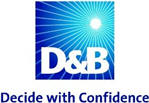 Ed note: On
March 8, I interviewed Tom Marsden, assistant vice president for the
Federal Sector division of Dun and Bradstreet (D&B) Government Solutions. The company is perhaps the most intense data companies in
the world. They update approximately 1.5 million records daily on more
than 100 million businesses worldwide. This interview provides an
insight into how they manage all the data, systems and methods that are
in place at D&B.
Ed note: On
March 8, I interviewed Tom Marsden, assistant vice president for the
Federal Sector division of Dun and Bradstreet (D&B) Government Solutions. The company is perhaps the most intense data companies in
the world. They update approximately 1.5 million records daily on more
than 100 million businesses worldwide. This interview provides an
insight into how they manage all the data, systems and methods that are
in place at D&B.D&B Facts
The company was founded in 1841. It has 37 offices around the world, 5,300 employees, 14 directly owned companies, and 17 strategic partners. The D&B database has more than 100 million businesses from 210 countries. Revenue is around $1.5 billion.
Tom Marsden Facts
Tom Marsden has more than 30 years of experience in information management, financial services and risk management. He is assistant vice president of D&B’s Government Solutions, where he oversees 20 government specialists who help federal agencies achieve their missions by utilizing D&B’s business information and integrated solutions
Hal Reid (HR): The D&B global database with 1.5 million daily updates, what kind of infrastructure do you have to support this level of data dynamics?
Tom Marsden (TM): We have a network of thirty information collection points around the globe and the task of data collection is a lot of work. For example, there are thousands of data sources and we have to maintain a level of Business Process Excellence as is expected of D&B. There are three primary sources of business information established when a business becomes active: telephone directories, government registrations of business, and trade associations. In the 210+ countries we operate in, all those formats are different. Naturally they are all in different languages and this requires normalization, but they are the bedrock of what we collect. D&B invests over $250,000,000 annually in data capture or about 16% of revenue.
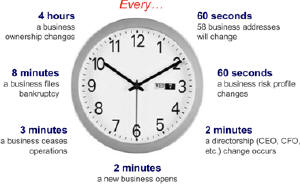 |
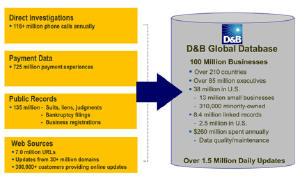 |
HR: Looking at your global network of companies and strategic partners, and the scope of the updates to your global database, is there another company that even comes close to the collection of business data?
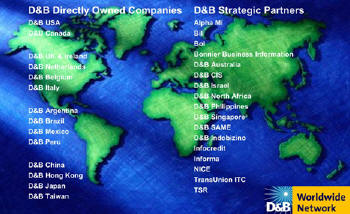 |
TM: Not on a global basis. There are competitors “in-country,” but no one else has the ability to normalize data across 210+ countries.
HR: A question about the D-U-N-S Number - using a nine-digit number to identify business types is similar to the U.S. Government NAICS codes. Is your level of discrimination comparable?
TM: No, the DUNS number is like a social security number; it is unique to each business. It uniquely identifies each business and the location for that business. When we receive an application for a DUNS number, we immediately geocode that business’ address here in the U.S.
HR: There is an example of aggregating data from multiple and disparate systems using the DUNS number. Are you using tools from business intelligence and data relationship mapping companies or is everything a D&B-developed application?
TM: Our primary focus is ensuring quality information through our patent-pending process called DUNSRight and delivering that information and insight through a variety of applications, including Oracle and Business Objects, among others.
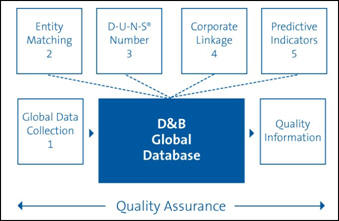 |
HR: How do your customers access your data? Are they accessing it through a Web portal, installed databases on their servers, or as a subscription service with ad hoc reports?
TM: Content is available in most every way the customer wants it. The primary method is transactional via the Web site. There are two other common sources. The data can be licensed via our channel partners. In the geospatial area, ESRI is a channel partner. The other method is through D&B books and CDs in the library market.
HR: Are businesses that are considered high-risk from a supplier perspective, from a grant perspective, or from a fraud or terrorist perspective aware of their ratings?
TM: Businesses can inquire as to their status and most information is readily available. However, some of our data is used by various customers, in customized models, to predict or evaluate risk. The predictive scores are not necessarily disclosed.
HR: In order to really understand the geospatial aspects of your data, you need mapping output of some type. How is the spatial data available? Do you support typical mapping formats or is everything tabular?
TM: We make our data available in the lowest common denominator -for example, ASCII text, delimited text, and simple formats.
HR: Different agencies have different uses for D&B data. Can you share how intelligence agencies may use D&B data?
TM: Let’s take intel agencies for example, they use a term, “reducing the haystack.” Simply put, they need to find the needle in a haystack. Well, we help make the search for the needle more manageable. Agencies need as much information as possible on persons of interest around the world. And so, by accessing our database, they can search by one criterion or multiple criteria depending on what they know - executive name, company name, country, address, linkage and/or industry. This reduces the haystack – fast.
HR: The corporate linkage concept is an interesting one. Can you explain how linkage is used differently at various government agencies?
TM: Sure, law enforcement agencies need to uncover hidden relationships between a person of interest and corporation. Regulatory agencies will look at linkage to identify responsible party and ability to pay. Procurement departments want to roll up spending to the corporate level for increased purchasing power. Lending agencies will look at total debt exposure at the parent level. Tax and revenue agencies can leverage corporate relationships to understand linkages between business entities or trading partners. And homeland security agencies could use this information to consider all corporate entities when quantifying organizational risk.
HR: Can you speak to how D&B helps agencies minimize threat to our country?
TM: No, but what I can say is that the government uses our information to help separate the known entities from the unknown.
HR: Your statement that “All 15 Cabinet-level departments, most federal agencies and over 75% of state agencies rely on D&B data” is very impressive. How does that compare to businesses that rely on your data?
TM: Over 90% of the Business Week 1,000 companies rely on D&B information.
HR: Tom, that completes my list of questions. I appreciate your time and want to thank you very much for the interview. I think you have provided some great insights to the readers of Directions on Data.